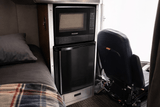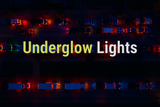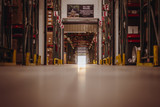What Do Semi Truck Clutch Brakes Do?
When you’re driving a big rig, every part of your drivetrain matters—especially the clutch brake.
It may be a small, often overlooked component, but without it, your gear shifts from a standstill could get rough, loud, or downright damaging.
So, let’s break down what a semi truck clutch brake is, what it does, and how to keep it from wearing out too soon.
What Is a Clutch Brake in a Semi Truck?
A semi truck clutch brake is a circular disc made with a friction surface, mounted between the release bearing and the transmission on the input shaft. It’s not the same as your main clutch (which engages and disengages the engine from the transmission). Instead, the clutch brake comes into play when the vehicle is stationary—like when you're shifting from neutral to first or reverse.
In simpler terms:
The clutch brake’s job is to slow down and stop the spinning input shaft inside a non-synchronized transmission so you can smoothly get the truck into gear.
Without it, you’re likely to hear that dreaded “clunk” or grinding sound when you try to engage a gear from a stop.
How It Works
Let’s walk through what happens inside the transmission:
- In Neutral, No Clutch Pressed:
The engine is turning the input shaft, but the truck isn’t moving—just internal gears spinning. - Clutch Pedal Halfway Down:
You disengage the master clutch, which cuts power from the engine to the transmission. But those gears? They’re still coasting—thanks to momentum and a whole lot of mass. - Clutch Pedal All the Way Down:
This is where the clutch brake steps in. The release bearing travels further and squeezes the clutch brake disc against the transmission housing. That friction slows (and eventually stops) the input shaft.
Now you can shift into first or reverse gear without grinding or damaging internal components.
Why Clutch Brakes Are Necessary (Especially in Non-Synchronized Transmissions)
Most semi trucks—especially older ones or heavy-duty haulers—use non-synchronized (a.k.a. "crash box") transmissions. These don’t automatically align gear speeds when you shift. It’s up to you—the driver—to make sure everything is spinning at compatible speeds.
That’s where the clutch brake comes in: it lets you shift into gear from a complete stop without clashing spinning gears.
How Clutch Brakes Fail (and What Causes Premature Wear)
Even though clutch brakes are built to last, they’re not indestructible. Here’s how they wear down—and why they often fail faster than expected:
1. Misuse During Range Shifts
The number one cause of clutch brake failure?
Pressing the clutch pedal all the way to the floor while the truck is moving.
That forces the clutch brake to try and stop a rotating transmission shaft—or worse, the moving truck. It's like trying to slam the brakes on an 80,000-pound vehicle with a little disc designed for a stationary input shaft.
One mistake like this can destroy your clutch brake instantly.
2. Lack of Grease
Clutch brakes are designed to operate with grease, not without it.
If you forget to lubricate the release bearing and clutch brake disc, friction becomes too harsh, and the material wears down fast.
3. Worn Friction Material
Like any brake, the clutch brake has a friction surface. Over time, that material naturally wears out. Once it’s gone, it’s metal-on-metal between the bearing and the transmission housing—a recipe for more damage.
4. Improper Linkage Adjustment
If your clutch linkage is out of spec, the release bearing may not move far enough to apply the clutch brake at all. Or it could squeeze the disc too hard during shifts, wearing it prematurely.
Signs Your Clutch Brake Might Be Failing
- You hear a grinding or clunking sound when shifting into first or reverse
- You have to jam the shifter harder to get it into gear from a stop
- The truck rolls slightly before the gear engages
- The clutch pedal feels sloppy or inconsistent when fully depressed
If you notice any of these, your clutch brake might be worn or out of adjustment.
Pro Tips to Make Your Clutch Brake Last Longer
Never push the clutch pedal to the floor when shifting at speed
Only do this when shifting from a dead stop (neutral to first/reverse).
Keep the linkage properly adjusted
Too little or too much pedal travel can ruin the brake.
Grease your release bearing and clutch brake regularly
Lack of lubrication is a silent killer.
Shift smoothly and with intention
Timing your shifts helps the clutch brake do its job without being abused.
Final Thoughts: Small Part, Big Responsibility
The clutch brake may be a small piece of your semi truck’s drivetrain, but its role is critical. It ensures smooth, damage-free shifts from a standstill and extends the life of your transmission. With proper use and maintenance, a quality clutch brake can go the distance—just like your rig.
If you’re replacing a worn-out clutch brake or installing a new one, always follow the manufacturer’s specs and don’t forget the grease. Your transmission—and your wallet—will thank you.
Recent Posts
-
The Ultimate Guide to DPF Filters & DEF Systems on Semi Trucks
Let’s break down how to maintain peak emissions performance and avoid excessive repairs. In this gui …30th Dec 2025 -
How to Choose the Best Refrigerator for Your Semi Truck
Every OTR truck driver needs reliable cooling for food and beverages on long haul drives. That's whe …26th Dec 2025 -
Haul of Fame: Inside Ivy’s Poison – The Wild 1986 Peterbilt 359 That Refused to Die
If you hang around truck shows long enough, you start hearing the same names over and over. Some are …19th Dec 2025 -
The Ultimate Guide to Custom Semi Truck Upholstery (Everything You Need to Know)
Almost any custom show truck prioritizes quality interior upholstery material and stitch design, be …16th Dec 2025 -
What Does the FASS Fuel System Do?
Want to protect and clean your diesel fuel system in one go? The FASS (fuel air separation system) i …12th Dec 2025 -
Semi Truck Muffler Guide
Need to lower your exhaust and engine noise, but aren’t sure what muffler to get? We offer Pittsburg …5th Dec 2025 -
Custom Underglow Light Setups on Semi Trucks
If you're looking for a way to dramatically enhance the look and presence of your semi truck at nigh …28th Nov 2025 -
Common Myths and Mistakes When Buying Aftermarket Semi Truck Parts (Ultimate Guide)
Cost, convenience, and make/model fitment are the top priorities when it comes to buying aftermarket …18th Nov 2025 -
Haul of Fame: Tony's Custom Retro W900 Kenworth
Tony Huttenstine is a seasoned owner-operator. Over the years, he has poured enormous time, money, a …14th Nov 2025 -
The 13 Best Christmas Gift Ideas for Truckers
Some of the best gifts for truck drivers are accessories that help make their job easier. Truckers s …11th Nov 2025














